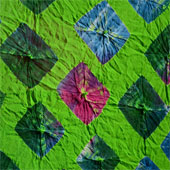Design Resource
Bandhani
Traditional Tie and Dye Technique
by
Bandhani is a tie and dye technique on woven cloth. Its name is derived from the word ‘bandhna’ (बाधंना) or ‘bandhej’ (बधंेज). The name Bandhani is used colloquially for both the technique of tie and dye as well as the final cloth. Bandhani is done on cotton, Gajji silk, wool, muslin, etc. The best quality Bandhani is done on finely woven cotton.
Bandhanis are brightly coloured and vibrant; and have a myriad of patterns; designs include floral, abstract, animal motifs or geometric patterns. Knots are arranged in various patterns to make interesting designs. The tied knots result in dots in the final dyed cloth. Fine dots in the design are due to meticulous tying of knots. Finely designed dots are a mark of high craftsmanship.
Traditionally, natural dyes were used extensively for the colours. For example, madder root (Rubia Cordifolia) for red; Sunflower petals for purple and yellow; Turmeric for yellow; Safflower derived dyes for red, brown and olive; and Indigo from the leaves of Indigofera Tinctoria for blue. With cheaper and faster binding chemical dyes available today very few dyers use the natural alternatives.
Naturally dyed Bandhani is considered to be of the highest quality and valued higher than its artificial chemical dyed variants. For the sake of authenticity and to prove that it is not screen-printed; the genuine Bandhani is sold with the threads still tied to the cloth.
References:
Ranjan and Ranjan ‐ (2007); Crafts of India: Handmade in India






